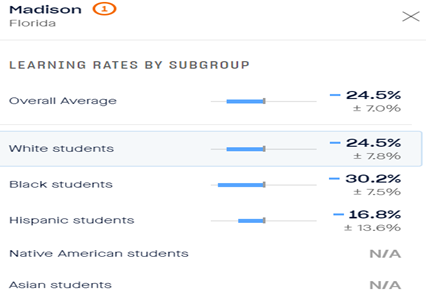Kate Payne of the Associated Press wrote a piece about the Madison County School District, a small rural area east of Tallahassee  titled School choice and a history of segregation collide as one Florida county shutters its rural schools.
titled School choice and a history of segregation collide as one Florida county shutters its rural schools.
Madison is closing three low-enrollment schools. Of course, people don’t like closing schools. Of course, the choice programs make for a ready scapegoat for district officials seeking to shift blame, but maybe journalists should thoroughly investigate alternative explanations.
Below, for example, is a chart from the Stanford Educational Opportunity Project demonstrating the overall learning rates for Madison students in grades three through eight from 2008 through 2019, and by student racial/ethnic subgroup:

Unlike academic proficiency rates, academic growth is not strongly correlated with student demographics. An academic growth rate of 0 would indicate students learned a year’s worth of math and reading on average per year. Sadly, Madison students score less than zero, a good deal less. In other words, families have had plenty of reasons to avoid enrolling their children in Madison.
Moreover, the net impact of the school consolidations will be to bring a bit of integration into a school district with high levels of segregation. If the choice programs played a major role in the closure of the three Madison schools, the choice programs would have promoted integration within the traditionally segregated district. The district plans to consolidate the three under-enrolled schools with another district school with a 70% Black student school majority. Black students make up a minority of the three closing schools, meaning the consolidated school would move to 58% Black.
Alas, however, Florida’s choice programs cannot take much credit. Step Up for Students’ own Scott Kent set the record straight in another story regarding the Madison consolidation
Scott Kent, a spokesperson for the organization, said there are only 166 students in the district participating in the program. Since Florida enacted one of the largest private school voucher expansions in the nation in 2023, only 47 additional students signed on to the voucher program, according to Kent, who added that only seven of those students transferred from a district public school.
For the record, the district undoubtedly should have consolidated these schools many years ago, and the seven students transferring out of the district with a scholarship represent a tiny fraction of the district’s enrollment. Madison County Superintendent Shirley Joseph noted that the consolidation will save the district millions of dollars, which it can use to improve teacher pay. Given the district’s dire need for higher quality instruction and learning, this sounds like it could be a splendid outcome.
The Payne article however ends in this fashion:
There's always talk about leaving the public schools, Joseph said, but she believes most families will stay. In the meantime, she’s focused on delivering the best education possible for the students she has — the ones who can’t leave.
A focus on academic achievement would be a welcome change if they manage to pull it off. In the meantime, we should celebrate rather than lament the fact that every single Madison student can leave. If they make the most of freedom, Madison educators will create enough of their own schools to encourage more overdue rational decision making and further district integration.
Welcome to life with liberated families, Madison. Delightfully, there’s no turning back.